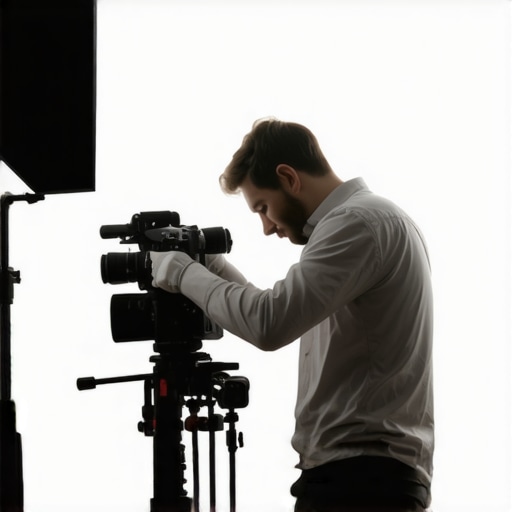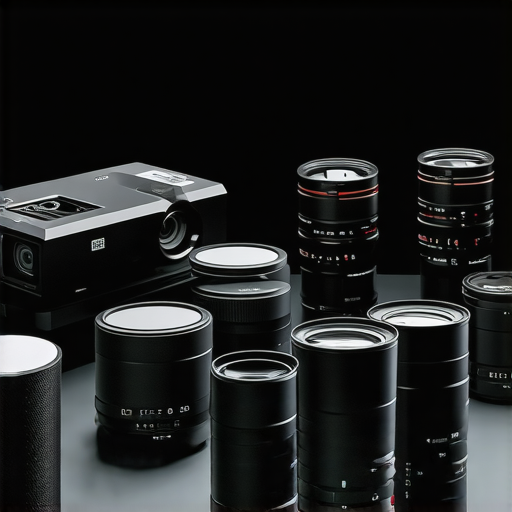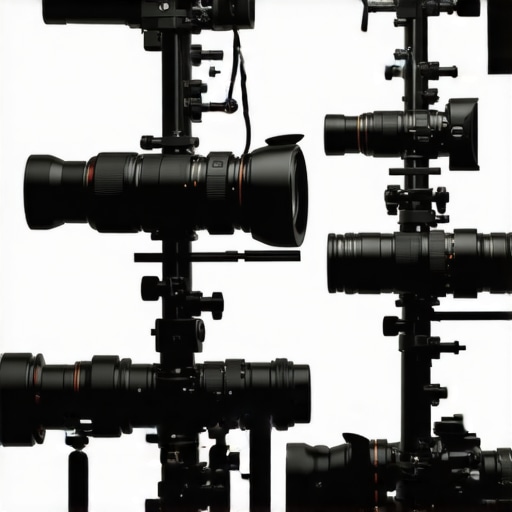How I Discovered the Magic of Cine Lenses
My journey into the world of professional filmmaking began quite unexpectedly. I remember the first time I rented a set of cine lenses for a short project; the difference in image quality was astonishing. The crispness, the depth of field, and the way they rendered motion made me realize how crucial lens choice is for storytelling. As I delved deeper, I learned that cine lenses are specifically designed to meet the demands of filmmaking, with features like minimal focus breathing and consistent color rendition, which are essential for seamless shots and post-production flexibility.
Why Camera Supports Became My Best Friends on Set
During my early days, I struggled with shaky shots and unstable footage. That’s when I started exploring various camera supports—tripods, gimbals, sliders, and stabilizers. Each tool offered a new level of control, allowing me to craft smoother, more professional-looking scenes. I found that investing in quality camera supports not only improved my technical skills but also boosted my confidence behind the camera. For instance, a good stabilizer can turn a simple walk-and-talk into a dynamic shot that captivates viewers.
Choosing the Right Cine Lenses and Supports: My Personal Tips
After experimenting with different brands and setups, I’ve realized that the key is balancing quality and budget. For cine lenses, I recommend checking out options like Zeiss and Cooke, which are renowned for their optical excellence. When it comes to camera supports, I swear by modular rigs and lightweight gimbals—I use the camera supports guide to pick the best gear for my needs. It’s also worth noting that a sturdy tripod can be invaluable for static shots, especially when capturing interviews or scenic landscapes.
Have You Ever Wondered How Cine Lenses Enhance Storytelling?
Understanding the impact of lens choice on storytelling has been a game-changer for me. Different lenses evoke different emotions—wide lenses create a sense of space and intimacy, while telephoto lenses can isolate subjects and add tension. The synergy between cine lenses and camera supports allows filmmakers to craft immersive worlds, much like a painter with their brushes. For more insights, I recommend exploring this comprehensive guide.
If you’re serious about elevating your filmmaking, I’d love to hear your experiences with cine lenses or support gear. Drop a comment below or reach out through our contact page—sharing knowledge is what makes our community thrive!
The Nuanced Role of Cine Lenses in Crafting Visual Narratives
In professional filmmaking, cine lenses are more than mere tools; they are the artists’ brushes that shape the emotional landscape of a story. Beyond their optical precision, cine lenses excel in maintaining consistent exposure and color fidelity across shots, which is crucial for seamless editing and visual cohesion. For example, angular focus and minimal breathing are features that allow a director to execute complex rack focuses without distracting shifts, enhancing storytelling finesse. Recognizing these subtle yet impactful differences is vital for filmmakers aiming to elevate their craft.
Mastering Support Gear: The Foundation of Professional Cinematography
Camera supports serve as the backbone of stable, dynamic shots. While tripods and monopods provide stability, advanced tools like gimbals and sliders unlock fluidity and creative movement. A well-chosen support system can transform a simple scene into an immersive experience. For instance, using a lightweight gimbal enables smooth tracking shots through crowded environments, adding energy and realism. The key lies in understanding the technical specifications and ergonomics of each support, ensuring they complement your shooting style and project demands. For more detailed guidance, explore this comprehensive support gear guide.
How Do Different Lens Choices Shape Audience Perception?
Choosing the right lens is akin to selecting the perfect musical score—it influences mood, focus, and audience engagement. Wide-angle lenses can evoke a sense of grandeur or intimacy, making viewers feel part of the scene. Conversely, telephoto lenses isolate subjects and compress space, intensifying emotional tension. The interplay between lens selection and support equipment allows for creative experimentation—like combining a macro lens with a stabilizer to capture intricate details without sacrificing smoothness. Understanding these elements empowers filmmakers to craft compelling, emotionally resonant visuals.

For a visual representation of how different lenses affect the scene, consider an image showing side-by-side shots taken with wide, standard, and telephoto lenses, illustrating their unique effects on composition and depth.
What Are the Practical Implications of Investing in High-Quality Cine Lenses and Supports?
Investing in top-tier cine lenses and camera supports directly impacts the quality and efficiency of your filmmaking process. High-quality lenses provide sharper images, better contrast, and more accurate color reproduction, reducing the need for extensive post-production corrections. Similarly, reliable supports minimize technical issues like wobbling or jitter, saving time during shoots and ensuring consistent results. While these investments can be substantial, they pay off in delivering professional results that meet industry standards. For further insights into choosing the right gear, visit this projection screen guide for understanding how support and display choices influence overall image quality.
If you’re eager to deepen your expertise or share your experiences, I encourage you to leave a comment below or contact us through our contact page. Your insights contribute to a vibrant filmmaking community that thrives on shared knowledge and continuous learning!
Unveiling the Subtle Art of Cine Lens Selection
Over time, I’ve come to realize that choosing the right cine lens isn’t just about optical quality—it’s about understanding how each lens’s unique characteristics influence storytelling. For instance, I remember experimenting with vintage lenses, which added a certain character and warmth that modern lenses sometimes lack. This exploration led me to appreciate the importance of lens personality in shaping mood and tone. As I delved deeper, I learned that factors like flare, bokeh, and even slight optical imperfections can be deliberately used to evoke specific emotions, aligning visual aesthetics with narrative intent.
Reflections on Support Gear: Beyond Stability
Initially, I viewed camera supports merely as tools for stability, but I’ve since discovered their potential for creative expression. A well-placed slider or gimbal can introduce dynamic movement that enhances storytelling, guiding viewers’ focus or building tension. For example, I recall a scene where a subtle dollie shot with a slider created an intimate feeling that static shots couldn’t achieve. The key is to understand the capabilities and limitations of each support type, then harness them to serve your story rather than just stabilize the camera. I often revisit this support guide to refine my gear choices and techniques.
How Do Personal Preferences Shape Our Choice of Gear?
In my experience, personal preferences—shaped by specific projects, shooting style, and even personality—play a significant role in selecting cine lenses and supports. For some, weight and portability are paramount, especially when filming handheld or on the move. For others, optical precision and minimal breathing take precedence. I’ve found that balancing these factors often involves trial, error, and honest reflection on what truly enhances my storytelling. I encourage fellow filmmakers to explore different brands and setups, keeping in mind that what works for one project or style might not suit another. To deepen your understanding, I recommend reading this comprehensive guide.
Can Support Equipment Elevate the Emotional Impact of Your Shots?
Absolutely. Support gear is not just about technical stability; it’s about emotional storytelling. Smooth camera movements can evoke feelings of calm, anticipation, or unease, depending on how they’re executed. I vividly remember using a stabilizer to follow a character through a chaotic marketplace, and the fluid movement contrasted with the hectic environment, amplifying the scene’s emotional depth. However, the true artistry lies in mastering the timing and subtlety of these movements. As you experiment, consider how each support tool can serve your narrative—sometimes, less is more. If you’re interested in exploring advanced techniques, check out this lighting and support mastery.
What Are the Nuances of Combining Lens and Support Choices for Maximum Impact?
Combining the right lens with appropriate support gear can unlock creative potentials I hadn’t fully appreciated early in my journey. For example, pairing a wide-angle lens with a steady tripod allows for sweeping landscape shots that feel grand and immersive. Conversely, using a telephoto lens on a handheld gimbal can produce intimate, tense moments that feel almost visceral. The key is understanding the story you want to tell and selecting gear that amplifies that vision. This synergy demands a nuanced approach—anticipating how support movements will complement optical characteristics, and vice versa. For further insights, I suggest exploring this projector and gear comparison for broader context.
Ultimately, my journey with cine lenses and support gear has been about discovery and refinement. Each project teaches me something new about how technical tools can serve artistry. If you’ve experienced similar revelations or have questions about your gear choices, I invite you to share your stories or reach out through our contact page. Our community thrives on shared knowledge and the collective pursuit of cinematic excellence.
Harnessing the Unique Character of Vintage Cine Lenses for Artistic Depth
My ongoing exploration into cine lens selection has revealed that vintage lenses offer a distinctive aesthetic that can profoundly influence storytelling. Unlike modern lenses, which often prioritize sharpness and minimal optical imperfections, vintage lenses introduce unique flare, bokeh, and slight optical aberrations that lend scenes a nostalgic or textured quality. I recall a project where I used a vintage Cooke lens, which imparted a warm glow reminiscent of classic cinema, elevating the emotional resonance of the narrative. To fully exploit these qualities, understanding the optical physics behind vintage lens behavior is crucial—delving into factors like glass composition and coating techniques can unlock creative potential. For an in-depth analysis, I recommend consulting this comprehensive guide on lens personalities.
The Art of Combining Support Systems for Dynamic Visual Narratives
Integrating support gear with lens choices opens avenues for sophisticated camera movement that enhances storytelling. For instance, pairing a lightweight gimbal with a macro lens allows for intricate, stable close-ups that draw viewers into minute details while maintaining fluid motion. Conversely, using a shoulder rig with wider lenses provides stability for long takes in dynamic environments. The key is to consider how each support system influences the camera’s agility and the scene’s emotional tone. I’ve found that experimenting with layered support setups—such as combining a steadicam with a slider—can produce complex, multidimensional shots that are both technically impressive and narratively compelling. For further insights, explore this detailed support guide.
What Are the Latest Innovations in Cine Lens Coatings and Their Impact on Image Quality?
Recent advancements in lens coating technology have significantly reduced flare and ghosting, especially in challenging lighting conditions. Multi-coating techniques, such as those employed by companies like Zeiss, enhance contrast and color fidelity, ensuring that scenes retain their intended mood without unwanted artifacts. Additionally, newer coatings help mitigate reflections from support gear or lighting fixtures, allowing for cleaner images even in complex setups. Understanding these innovations enables filmmakers to make informed decisions that optimize image quality across all shooting scenarios. For a closer look at these technological breakthroughs, check out this resource on lighting and lens technology.
Engaging Your Audience with Thoughtful Lens and Support Choices
Beyond technical mastery, deliberate selection of lenses and support gear can dramatically shape audience perception. For example, choosing a tilt-shift lens combined with a dolly shot can add a surreal, dreamlike quality, immersing viewers into the narrative’s emotional landscape. The support system’s role in facilitating seamless movement allows for storytelling rhythms that mirror the scene’s mood—be it tension, serenity, or chaos. I encourage fellow filmmakers to experiment with unconventional pairings, like combining anamorphic lenses with handheld stabilizers, to discover new visual languages. Share your experiences or ask questions about pushing your technical boundaries by reaching out through our contact page.
Things I Wish I Knew Earlier (or You Might Find Surprising)
The Subtle Power of Lens Character
One thing I wish I’d understood sooner is how much vintage cine lenses can add emotional depth to a scene. Early in my journey, I focused solely on sharpness and modern coatings, but discovering the unique flare, bokeh, and imperfections of vintage lenses opened new creative doors. They can evoke nostalgia or mood in ways that modern lenses sometimes struggle to match.
The Hidden Impact of Support Equipment
I used to think stabilizers and tripods were just for stability, but I’ve learned that the right support gear can dramatically influence storytelling. A slider or gimbal can introduce movement that guides emotion or creates tension, transforming a simple shot into a powerful moment. It’s about how you use these tools, not just having them.
The Balance Between Quality and Budget
When starting out, I often felt overwhelmed by the vast array of options. Over time, I realized that prioritizing quality in essential lenses and supports, while being strategic with budget-friendly choices, is key. For instance, investing in a reliable tripod or a versatile zoom lens can make a noticeable difference without breaking the bank.
The Role of Coatings in Challenging Conditions
Modern multi-coatings are game-changers. They reduce glare and flare, especially in difficult lighting situations, ensuring your images stay clean and vibrant. This technical advancement saves me from post-production headaches and helps keep the story visually consistent.
The Emotional Palette Created by Gear Choices
Every piece of gear I choose subtly influences the mood of my scenes. Wide lenses paired with steady support evoke space and intimacy, while telephoto lenses with handheld support can heighten tension. These decisions, often overlooked, are powerful tools for storytelling when approached thoughtfully.
Resources I’ve Come to Trust Over Time
- CineGear’s Support Gear Guide: This resource helped me understand the nuances of different support systems and how to match them to my shooting style. It’s a must-read for anyone serious about cinematography.
- Zeiss Optical Insights: Their detailed explanations of lens coatings and optical physics deepened my appreciation of image quality and how to leverage coatings in various lighting conditions. Highly recommended for technical clarity.
- Vintage Lens Forums: Engaging with communities focused on vintage lenses has been invaluable. They share real-world experiences and tips on getting the most character out of classic glass.
Parting Thoughts from My Perspective
Reflecting on my journey, I realize that mastering cine lenses and support gear is as much about storytelling as it is technical skill. The gear choices I make shape not just the visuals but also the emotional tone of my projects. If this resonates with you, I’d love to hear your experiences or questions. Feel free to share your thoughts or reach out through our contact page. Remember, every shot is an opportunity to tell a compelling story—gear is just the brush, but your vision creates the masterpiece.


I really appreciated that this post emphasizes the nuanced role of cine lenses beyond just optical quality. As someone who’s experimented with vintage lenses, I can say they definitely add a lot of character and depth to storytelling, especially when aiming for a nostalgic or textured feel. The mention of lens personality—flair, bokeh, minor imperfections—resonates with my experience, since these elements can really evoke emotion in a scene. I’ve also found that support gear isn’t just about stability; it’s a creative tool that shapes movement and mood just as much as the lens choice. Have others here experimented with combining vintage lenses with support systems like gimbals or sliders? How did it influence your storytelling? Would love to hear different approaches or tips for harmonizing gear for maximum emotional impact.
This post really sheds light on how vital cine lenses are beyond their optical attributes; their character really influences the emotional tone of a scene. I’ve had a similar experience using vintage lenses like Cooke or Zeiss, and I agree that they add a nostalgic or textured feel that modern lenses sometimes lack. When I combine vintage lenses with support gear like sliders or gimbals, the results can be quite remarkable. For example, small movements with a slider paired with the unique flare or bokeh of vintage glass create a rich, immersive experience.
One challenge I’ve faced is managing the optical quirks of vintage lenses, such as flare or slight aberrations, which can sometimes be unpredictable. Do others have tips on how to best incorporate these into a controlled shoot without sacrificing consistency? I’m also curious—how do you balance characterful lenses with modern digital workflows, especially for post-production color matching? Sharing these insights might help newcomers navigate the exciting yet nuanced world of cine lens storytelling.